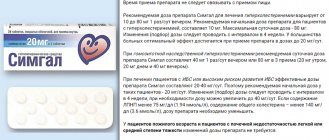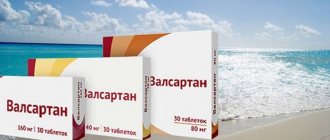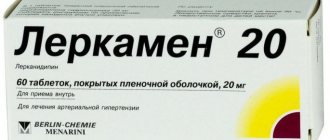Pharmacological properties of the drug Vasilip
Simvastatin is a drug that reduces cholesterol levels. It is an inhibitor of HMG-CoA reductase, an enzyme that takes part in the synthesis of cholesterol in the liver. Simvastatin reduces the concentration of total cholesterol in the blood serum, as well as the concentration of LDL cholesterol and TG in the blood plasma. The concentration of VLDL is also reduced with the use of simvastatin, and the concentration of HDL is moderately increased. In addition, simvastatin exhibits a number of positive effects: improves the function of the endothelium of blood vessels; has an antioxidant effect and slows down the proliferation and migration of cells during the atherosclerotic process. Simvastatin in the form of an inactive lactone is absorbed in the digestive tract from 61 to 85% and is converted into the active therapeutic form in the liver. During the initial passage through the liver, 79% of the absorbed drug is retained there and metabolized. The maximum concentration of active metabolites is achieved 1.1-3 hours after administration of the drug. After absorption, simvastatin is hydrolyzed in the liver to form the active β-hydroxy acid form. Plasma protein binding is 98%. The drug and its active metabolites are located mainly in the liver, which is the site of manifestation of their activity. The half-life of the main metabolite is 1.9 hours, and the total clearance from the body is 31.8 l/h. About 60% of the drug is excreted in the feces (unabsorbed drug, as well as its metabolites in bile) and 13% in the urine (inactive metabolites). The therapeutic effect is achieved within 4–6 weeks of therapy.
Pharmacological parameters
Simvastatin is a blocker of the enzyme 3hydroxy-3methylglutoryl-CoA reductase. This substance is responsible for the production of cholesterol in the liver. It is thanks to this that Vasilip has the ability to reduce the amount of cholesterol in the body.
Simvastatin contains a lactone ring in its structure, which is hydrolyzed after entering the body. It is similar to coenzyme A, therefore it successfully attaches to the receptor of this enzyme according to the principle of competitive inhibition. Another part of the active substance molecule blocks the transformation of hydroxymethyl glucanate into mevalonate, which is an intermediate product of cholesterol.
The drug reduces the concentration of triglycerides and total cholesterol in the body. When taking Vasilip, the amount in the blood decreases and lipoproteins are very low. This occurs due to a slight increase in high-density lipoproteins.
Vasilip does not affect the functional performance of hepatic and lipoprotein type lipases, and also does not change the synthesis of fatty acids. Therefore, the effect of this drug on triglycerides is secondary. The decrease in their level is associated with the expression of remnant receptors of hepatocytes by the active substance of the drug.
Vasilip not only reduces the level of bad cholesterol in the blood. It also has some other positive effects. The drug normalizes the functioning of vascular endothelial cells. In atherosclerotic pathology, it slows down cell migration and proliferation.
Ascorbic acid and microcellulose in the composition of the drug provide its antitoxic effect. Vasilip reduces the likelihood of life-threatening situations arising from cardiovascular pathologies.
It has been noted that Vasilip is able to increase the rheological properties of blood and has antiproliferative properties. The product significantly improves the condition of the walls of the elements of the circulatory system and the aorta. When taking Vasilip, there is a significant reduction in the incidence of cardiac and vascular dysfunction. A pronounced therapeutic effect of the drug is observed after a month of regular use.
Indications for use of the drug Vasilip
IHD IHD and a high risk of developing cardiovascular complications (heart attack or transient ischemic disorders). The drug reduces the level of total cholesterol and LDL cholesterol in patients with coronary artery disease and thus slows the progression of coronary atherosclerosis, reduces the risk of myocardial infarction and mortality as a result. Reduces the risk of complications after coronary revascularization (coronary artery bypass grafting and percutaneous transluminal coronary angioplasty). Hyperlipidemia Vasilip regulates the serum concentrations of total cholesterol, LDL cholesterol, HDL cholesterol and TG in patients with primary hyperlipidemia (type IIa and IIb), including polygenic hypercholesterolemia, heterozygous hereditary hypercholesterolemia and mixed hyperlipidemia. Vasilip is also used to reduce high levels of total cholesterol and LDL cholesterol in patients with homozygous hereditary hypercholesterolemia.
Reviews about Vazilip
Vasilip is a fairly popular drug for the treatment of hypercholesterolemia. It has a pronounced effect and has good reviews from doctors and patients.
Answers to questions about Vasilip:
- Hello, I suffer from diabetes. The doctor prescribed Vazilip for me. I was also prescribed a diet with a minimum amount of animal fats. How is diabetes related to cholesterol-lowering medication, and should I take it? (Olesya, Kyiv).
- Hello, Olesya! If your doctor has prescribed Vazilip to you, then you have indications for taking it, so you need to treat with it. Hypercholesterolemia often develops in diabetes mellitus. This significantly increases the risk of developing serious diabetes complications. Therefore, lipid-lowering drugs are often prescribed for this disease. (Oleg Nikolaevich, endocrinologist, Saratov).
- I am 60 years old. The doctor said that large atherosclerotic plaques appeared on my vessels. He prescribed me several medications, including Vasilip. A friend said that she tried to take it, but it could not cure atherosclerosis. Why was Vasilip prescribed to me? (Anna Mikhailovna, Yekaterinburg).
- Hello, Anna Mikhailovna. Unfortunately, it is not yet possible to completely cure atherosclerosis. Vasilip will not remove existing plaques from the walls of blood vessels, but it will help prevent the formation of new ones. This drug is prescribed to prevent the progression of the disease and the occurrence of heart attack and stroke. Therefore, listen to your doctor’s advice and follow your diet. (Marina Ivanovna, Kirov, therapist).
Use of the drug Vasilip
The recommended dosage range is 10 to 80 mg per day when administered orally as a single dose in the evening. If necessary, the dose can be changed every 4 weeks of treatment until a maximum dose of 80 mg per day is reached when administered as a single dose in the evening. A dose of 80 mg per day is recommended for use only in the treatment of patients with severe hypercholesterolemia and a high risk of developing cardiovascular complications. Hypercholesterolemia: The usual starting dose is 10–20 mg per day when administered once in the evening. Patients who require a significant reduction in LDL cholesterol levels (more than 45%) should begin treatment with a dose of 20-40 mg per day once in the evening. Dose adjustments, if necessary, should be made as described above. Homozygous hereditary hypercholesterolemia: Based on the results of a controlled clinical trial, the recommended dose of simvastatin is 40 mg per day 1 time in the evening or 80 mg per day when used in 3 doses - 20 mg in the morning, 20 mg in the afternoon and 40 mg in the evening. In such patients, simvastatin should be used as an adjuvant to other lipid-lowering treatments (eg, LDL apheresis) or when other treatments are not available. Prevention of cardiovascular complications: For the treatment of patients with coronary artery disease and a high risk of developing cardiovascular complications (regardless of the presence or absence of hyperlipidemia), the recommended dose of simvastatin is 20 to 40 mg per day with a single dose in the evening. Therapy must be started along with diet and exercise. Dose adjustment, if necessary, should be carried out as described above. Concomitant treatment: Simvastatin has an effective effect both when used independently and in combination with bile acid sequestrants (colestyramine, colestipol). The drug must be taken either more than 2 hours before using a bile acid sequestrant, or more than 4 hours after use. In patients receiving cyclosporine, gemfibrozil, other fibrates, or niacin at a lipid-lowering dose (1 g per day) concomitantly with simvastatin, the dose of simvastatin should not exceed 10 mg per day. In patients taking amiodarone or verapamil along with simvastatin, the dose of simvastatin should not exceed 20 mg per day. Dosing in Renal Impairment: For patients with mildly reduced renal function, no dose adjustment is necessary. For patients with severe renal impairment (creatinine clearance less than 30 ml/min), doses above 10 mg should only be used if absolutely necessary and under close medical supervision. Use in elderly patients: There is no need to change the dose.
Composition and release forms
The main working component of the drug is simvastatin. Its quantity in one tablet depends on the form of the drug. The medicine also includes a number of additional ingredients. Not all of them have pharmacological activity, but provide better absorption of the drug.
Composition of Vasilip:
- Corn starch;
- Dry citric acid;
- Lactose dihydrate;
- Talc;
- Microcrystalline cellulose;
- Sodium propylene glycol;
- Butyloxyanisole;
- Ascorbic acid;
- Potassium stearate;
- Titanium dioxide.
Vasilip tablets are biconvex and white. They are covered with a film-type shell and have a groove for dividing the drug into equal portions on one side.
Forms of release of the drug:
- Vasilip 10 mg;
- Vasilip 40 mg;
- Vasilip 20 mg.
Side effects of the drug Vasilip
Well tolerated by most patients, side effects are usually mild and transient. Constipation, nausea, dyspepsia, abdominal pain, diarrhea, vomiting, headache, sleep disturbance and increased activity of liver enzymes (AST and ALT) may occur; Dizziness, increased fatigue, muscle weakness, itching and alopecia are less common. Extremely rarely (in isolated cases), depression, peripheral neuropathy, impaired potency and renal function, proteinuria, pancreatitis, lens opacification, dermatomyositis, skin rash and eczema, myopathy, manifested by muscle pain, muscle weakness and an increase in the muscle fraction of CPK, are possible. In exceptional cases, rhabdomyolysis develops with further renal failure. The risk of developing myopathy with rhabdomyolysis is increased in patients using another lipid-lowering drug, cyclosporine, or certain drugs that increase the level of simvastatin in the blood. Hypersensitivity syndrome, also rare, can manifest as angioedema, vasculitis, dermatomyositis, thrombocytopenia, eosinophilia, increased ESR, symptoms and signs of arthritis, skin rashes, photosensitivity, fever and flushing.
Tips for using the product
To make Vasilip’s use as effective and safe as possible, you need to take into account several nuances regarding its use. This will reduce the likelihood of side effects.
Tips for using Vasilipa:
- When using Vasilip by girls and women of childbearing age, they must be warned about the need to use reliable contraception. Vasilip can lead to impaired fetal development.
- You cannot combine Vasilip with grapefruit juice. With this combination, symptoms of overdose may occur.
- The drug can only be used in conjunction with dietary meals. Otherwise it will not be effective.
- To achieve maximum effect, the product is applied at the same time. It's better to do this in the evening.
- Due to the fact that a large number of cases of myopathy and muscle cramps occurring when taking Vasilip have been recorded, it is not recommended to control complex mechanisms when using it.
- Increasing physical activity will help improve the effectiveness of the product.
Special instructions for the use of Vasilip
Simvastatin therapy may cause an increase in the level of hepatic transaminases in the blood serum. Before starting treatment, it is recommended to determine the level of transaminases in the blood serum and then regularly monitor these indicators throughout the entire period of treatment. In most cases, such a slight increase does not require discontinuation of the drug. If the level of transaminases in the blood serum is 3 times higher than the upper limit of normal, treatment with the drug must be discontinued. It is recommended to prescribe simvastatin with extreme caution to patients who abuse alcohol and/or have liver disease. When taking Vasilip, you must avoid drinking alcohol. Simvastatin may cause an increase in the activity of the muscle enzyme CPK, and in rare cases myopathy may develop. Myopathy is manifested by a significant (more than 10 times the normal value) increase in CPK levels, which is accompanied by pain, stiffness and muscle weakness. In the most severe cases, rhabdomyolysis (destruction of muscle tissue) may develop. This can lead to the development of acute renal failure. The risk of myopathy and rhabdomyolysis is increased when simvastatin is co-administered with strong CYP3A4 inhibitors (eg, itraconazole, ketoconazole, HIV protease inhibitors, erythromycin, clarithromycin, telithromycin and nefazodone). If treatment with itraconazole, ketoconazole, HIV protease inhibitors, erythromycin, clarithromycin, telithromycin and nefazodone is necessary, the use of simvastatin should be discontinued during such treatment. In addition, Vazilip should be used with caution when taken simultaneously with cyclosporine, other fibrates, and niacin. The increase in CK activity should also be taken into account when carrying out the differential diagnosis of chest pain. The safety and effectiveness of simvastatin in children and adolescents under 18 years of age have not been established. During pregnancy and breastfeeding. The drug is contraindicated during pregnancy and breastfeeding. Women of reproductive age can take Vasilip only if the possibility of pregnancy is completely excluded. Impact on the ability to drive vehicles and work with complex mechanisms . Simvastatin has no or almost no effect on the ability to drive vehicles or operate other machinery. However, dizziness has occasionally been reported in post-marketing studies.
Advantages and disadvantages of the product
Vasilip is often prescribed for high blood cholesterol levels. It has a lot of advantages for which doctors and patients appreciate it.
Benefits of Vasilip:
- The drug has the ability to significantly reduce the level of bad cholesterol in the blood. It is effective in cases where diet and exercise do not give the desired result.
- In addition to its direct purpose, the product improves the condition of the walls of blood vessels and the myocardium, removes toxins from the body and improves blood flow. Thanks to this, it can be used to effectively prevent serious complications of cardiovascular diseases.
- The drug can be used for a number of diseases. Although it is not officially indicated, it is often used to prevent diabetes complications.
- Vasilip can be used regardless of the time of meal, which is not saturated with cholesterol. This will not affect its lipid-lowering properties.
- The cost of the drug is very budget. Vazilip is cheaper than many of its analogues.
In addition to the advantages, this tool also has some disadvantages. They also need to be taken into account.
Disadvantages of Vasilip:
- The drug has many side effects. Some of them occur quite often;
- Basilip can affect a person's ability to drive a car;
- Taking the drug is not possible in all cases;
- Without following a low-fat diet, the product will not have a pronounced effect;
- Vasilip is incompatible with many substances;
- Vasilip has the ability to penetrate the placenta and breast milk. It can even cause mutations in the fetus.
Drug interactions Vasilip
Co-administration of simvastatin with cyclosporine, fibrates, nicotinic acid, niacin, erythromycin, clarithromycin, ketoconazole, itraconazole and nefazodone increases the risk of developing myopathy with rhabdomyolysis and acute renal failure. These drugs are inhibitors of the CYP 3A4 enzyme, which is involved in the metabolism of Vasilip in the liver. Similar complications can occur with the combined use of simvastatin in high doses (80 mg) with amiodarone and verapamil. When taken concomitantly with ritonavir, the concentration of simvastatin in the blood serum may increase. The simultaneous administration of simvastatin and warfarin may enhance the anticoagulant effect of the latter and thus increase the risk of hemorrhagic complications. In patients taking simvastatin and digoxin concomitantly, serum digoxin levels may be increased and such patients should be under medical supervision.
Overdose of the drug Vasilip, symptoms and treatment
Several cases of simvastatin overdose have been described, which were not accompanied by the development of any specific disorders or negative consequences. In case of overdose, standard measures are carried out (gastric lavage and administration of activated carbon, monitoring the vital functions of the body). It is also necessary to monitor liver and kidney function and serum CPK levels. If myopathy occurs with the development of rhabdomyolysis and acute renal failure, the use of the drug should be stopped immediately and, if necessary, hemodialysis should be performed.
Indications and contraindications
The intake and dosage of Vasilip is determined by the attending physician on the basis of clinical symptoms and laboratory test results. Direct indications for use are:
- increased content of all cholesterol fractions in a biochemical blood test (hypercholesterolemia);
- for the purpose of preventing heart attack and stroke in patients with atherosclerotic lesions of the vascular system or with moderate forms of diabetes mellitus;
Diabetes
- mixed dyslipidemia, which is not amenable to non-drug correction (special diet tables, physical therapy, physiotherapeutic procedures);
- for secondary prevention of atherogenic lesions after coronary artery bypass surgery, coronary angioplasty.
Among the contraindications to prescribing the drug are:
- increased levels of transaminases in the blood of idiopathic origin, since the reaction from the use of the drug can be extremely negative;
- individual intolerance to the components of the drug or if there were allergic reactions to the use of simvastatin;
- pregnancy and lactation - if pregnancy occurs, the drug is discontinued, as there is a teratogenic effect on the fetus;
- cannot be taken during concurrent therapy with drugs: Gemfibrozil, Cyclosporine, Danazol;
- liver dysfunction and diseases of the biliary system in the acute phase (liver failure, cirrhosis, acute cholecystitis).
Liver failure
- not used in persons under 18 years of age due to the lack of research on the safety of the active substance on a growing child’s body;
- for myopathy – the drug can provoke increased symptoms and paralysis;
See also:
Instructions for use of the drug Cardiostatin® and its analogues





